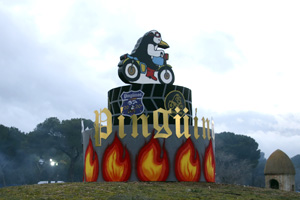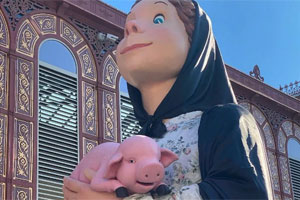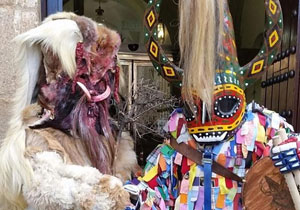Fallas in honor of the Virgen de Ribera
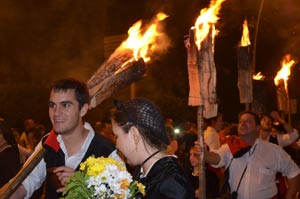
What are the fallas in honor of the Virgen de Ribera?
Every year, on June 17th, the celebrations in honor of the Virgen de Ribera, the patron saint of La Pobla de Segur in the region of Pallars Jussà in Catalonia, take place. The origin of the fallas dates back to ancient pagan traditions related to the summer solstice and the worship of the Sun.
This festival, like other festivities in the Pyrenees, has been recognized as Intangible Cultural Heritage of Humanity by UNESCO.
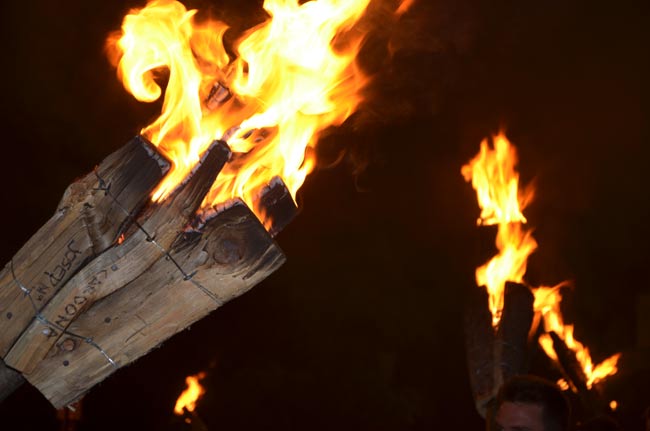
On the afternoon of June 17th, the participants, known as "fallaires," climb the Santa Magdalena mountain with the "fallas," which are structures built with hazel and dry pine in the days leading up to the festival. Meanwhile, the young women of the village dress in traditional Catalan costumes and gather with their families at the Molí de l'Oli as night falls.
As it gets darker, the "pubilles" (young women) and the inhabitants of La Pobla descend to the foot of the Santa Magdalena mountain to await the fallaires. When they arrive, a procession takes place to the church, where an offering is made to the Virgin of Ribera. Finally, sardanas are danced in the Plaza de la Pedrera, and a popular dinner is organized for the fallaires and the pubilles.
Origin and History
Since ancient times, the origin of the fallas in the Pyrenees has been linked to the instinctive attraction to flames, dating back to prehistory. In La Pobla, the tradition of bringing down the fallas began in the 1950s when the village was an important economic center, and its festivities were an asset to the region. It was Mayor Boixareu who promoted this celebration in collaboration with the Esbart Dansaire, a group of choirs and dances. Along with other fallas and solstice fire festivals on both sides of the Pyrenees, they were recognized by UNESCO as Intangible Cultural Heritage of Humanity on November 1, 2015.
Over the years, the fallas have faced various difficulties, including fires on the Santa Magdalena mountain, and at some point, they were on the verge of disappearing. Currently, the Association of Fallaires i Pubilles de La Pobla de Segur is responsible for promoting and organizing these festivities, and they have managed to revitalize the celebration with the participation of over a hundred pairs of fallaires this year.
Until recently, men were responsible for descending from the mountain with torches, while women waited for them on the path of Santa Magdalena with "coca," wine, and a bouquet of flowers to offer to the Virgin. Once the pairs were reunited, they paraded through the village until they reached the Market Square, where a large bonfire was lit with all the torches. Then, the floral offering to the Virgin of Ribera took place, and finally, the celebration culminated with a grand sardana danced by all the pairs in the Town Hall Square.
Recently, members of the Association of Fallaires i Pubilles, mostly women, proposed and succeeded in eliminating gender roles in the festival. Starting on June 17, 2018, both men and women can play the roles of fallaire and pubilla. The great challenge for the association will be to reconcile historical memory with the diversity of current roles. Currently, all these changes have been very well received by the residents and participants.
What to See in La Pobla de Segur
La Pobla de Segur, located in the Pallars Jussà region in Catalonia, offers visitors various attractions to enjoy its charm and beauty. Some of the highlights to visit in La Pobla de Segur are:
- Castle of Mur: Located a few kilometers from La Pobla de Segur, this imposing medieval castle offers a stunning panoramic view of the region. It is a perfect place to explore history.
- Parish Church of Santa María: This Gothic church, built in the 14th century, is an emblematic landmark in La Pobla de Segur. Its architecture and historical details make it an interesting place to visit.
- Museum of the Convent of the Augustinian Fathers: This museum is located in a former 17th-century convent. It houses a collection of sacred art and historical objects that showcase the rich cultural and religious heritage of the area.
- Walk around Lake La Pobla de Segur: The Sant Antoni reservoir, near La Pobla de Segur, offers a beautiful natural setting with calm waters surrounded by mountains. It is an ideal place for walking, enjoying nature, and engaging in water activities.
- Hiking Routes: La Pobla de Segur is surrounded by spectacular nature and offers various hiking routes that allow you to explore the mountainous landscapes of the region. The Natural Park of the High Pyrenees and the Aigüestortes i Estany de Sant Maurici National Park are nearby and ideal for hiking enthusiasts.
- Local Gastronomy: You must try the delicious local cuisine of La Pobla de Segur. Typical dishes of the region, such as "escudella i carn d'olla" (Catalan stew), river trout from Noguera Pallaresa, or the local cheese, are a delight for the palate.
These are just some examples of what you can see and enjoy in La Pobla de Segur. The natural beauty, historical heritage, and rich culture of the region make it an interesting destination to explore.
What to Eat in La Pobla de Segur
The popular traditional cuisine of La Pobla de Segur offers a delicious variety of dishes that reflect the region's rich culinary culture. Here are just a few examples of the popular traditional cuisine of the region:
- Escudella i carn d'olla: This dish is a traditional Catalan stew consisting of a meat and vegetable soup. It is prepared with a variety of ingredients, such as pork, beef, chicken, sausages, chickpeas, potatoes, carrots, and cabbage. It is a hearty and comforting dish, perfect for cold days.
- River Trout from Noguera Pallaresa: La Pobla de Segur is surrounded by rivers and reservoirs that offer a plentiful supply of fresh trout. This fish is highly valued in the area and prepared in various ways, such as grilled, baked, or marinated. It is a tasty dish characteristic of the region.
- Grilled Lamb: Roasted lamb on the grill is another popular dish in La Pobla de Segur. The lamb is slowly cooked over the coals, giving it a juicy and smoky flavor. It is usually served with roasted potatoes and aioli, a garlic sauce.
- Local Cheese: The Pallars Jussà region is known for its artisanal cheese production. The local cheese is made from sheep's milk and has a creamy texture and distinctive flavor. It is perfect to enjoy on its own, on cheese boards, or as an ingredient in other traditional dishes.
- Cremadillos: These traditional sweets are very popular in La Pobla de Segur during the festivities. They are small portions of fried and crispy dough, coated with sugar and cinnamon. They are a delicious treat to enjoy at any time.
The combination of local ingredients, traditional recipes, and authentic culinary techniques make the food of the region a unique and tasty experience.

